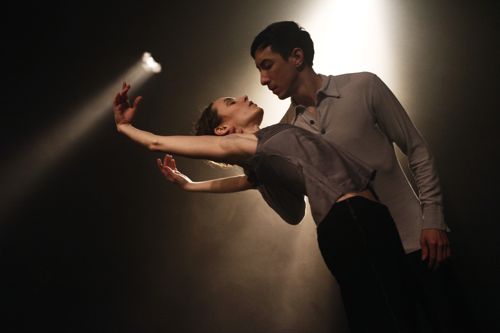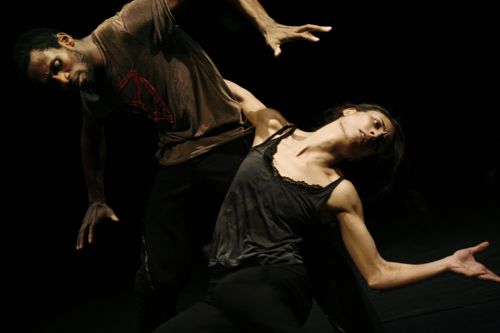Crystal Pite / Kidd Pivot Frankfurt RM / Baryshnikov Arts Center, NYC / February 13 and 24, 2012
The Canadian choreographer Crystal Pite and her Germany-based troupe, Kidd Pivot Frankfurt RM, remain well worth watching, as their recent New York showing of The You Show demonstrated.
 Anne Plamondon and Peter Chu in Crystal Pite’s The You Show
Anne Plamondon and Peter Chu in Crystal Pite’s The You Show
Photo: Julieta Cervantes
The two Pite works that I’d seen before, including Dark Matters, throbbed with intent, offering the viewer a rich cache of meaning though they operated literally only some of the time. Pite’s imagination is far-ranging. Despite being a child of the dance world’s postmodern era, she is nevertheless addicted to fairy tales. She’s at home in the blending of the actual and the magical, fascinated, for instance, by the eerie relationships puppets (or their equivalents) might take on as they interact with humans. On the other hand she’s interested in the realities of the human condition: fear, need, curiosity, empathy, desire. And always, being a woman of today, she tends to work on the dark side.
Her latest work, The You Show, features veritable darkness punctuated by glaring flashes of light or feeble illumination in a pervasive gloom. In the first three of its four segments, the piece focuses on—one by one—the mystery of human connections; the subtle horror of feeling that your “self” consists of two people; and then the experience of human calamity at the No Exit level.
In a program note Pite urges the viewer to identify with the figures of her dance as if their action were his or her own. Here, I think, she goes too far. Such an effect can be hoped for, but is awkward—and likely to be resisted—when it’s overtly pressed upon one’s audience.
In the initial segment, “A Picture of You Falling,” the action is accompanied by a taped, bare-boned, matter-of-fact account of what the dancers are elaborating physically and far more enigmatically. The dancing provides a richness the words can’t convey; the spoken element is coolly repressed, spare, and almost numbingly repetitive. Clearly the narration is the prose; the dancing furnishes the poetry.
A man and a woman—quite young, it would seem—are tracked, first separately, then as their paths cross, finally as they engage in a sexual relationship and inevitably drift out of it. Throughout, the emotions of both remain ambiguous, the point being that love, even in its relatively simple erotic guise, has myriad moods, many of them contradictory. However the choreography does arouse in the watcher a tenderness for this pair, if not quite the desired bonding with them. The sensitive dancers were Peter Chu and Anne Plamondon.
In contrast to this postmodern “romance,” Eric Beauchesne and Jirí Pokorny, solidly and similarly built men, well launched in life, play a pair of eerily alike antiheroes in “The Other You.” Pite gives them an extended version of that old theatrical ploy, the mirror dance, in which a pair of physically matched performers, positioned faced to face, creates the illusion of a real person confronting his (or her) looking-glass reflection. The celebrated Danish choreographer August Bournonville used the device—for two women—in his 1856 La Ventana. That piece is still performed but the idea of the mirror dance was old even in Bournonville’s day.
Pite expands the trick and gives the encounter of lookalikes an escalating mood of rivalry, aggression, and horror, as the two men wrestle for domination over and escape from one another. How would you feel, Pite seems to propose, if “the other you” was your enemy—perhaps just because you and your threatening doppelgänger had so much in common?
The men’s moves, particularly in the hands, seemingly built to claw and throttle, are frequently grotesque. Their bodies are terrifyingly strong, amazingly flexible despite their being tightly knit, and almost rubbery, like those of a Gumby with a few joints added. Hurled to the floor, they seem to be repelled by it, as if repose in defeat were not a possibility.
The background sound ranges from dogs’ barking, occasional cries from the combatants (“No, no, no, no”), and Beethoven’s Moonlight Sonata, which, unsettlingly, gives brutal conflict the air of a dance.
“The Other You” is far too long, but affecting nonetheless.
In Das Glashus (The Glasshouse), Pite takes the viewer into the most profound reaches of the dark, where she gives us a man and a woman (Yannick Matthon and Cindy Salgado) truly at the end of their existence as viable human beings. I imagined the situation of Holocaust victims who had experienced the extermination of their loved ones and, utterly without hope, knew that they, too, would shortly be extinguished. I took the sound of huge panes of shattering glass as a metaphor for Kristallnacht.
The woman often assumes a posture of stoic endurance; at other times, she bends softly to comfort the man with her embrace. Is he her husband, her son, or, perhaps, the only one left alive on the scene? The woman can still intermittently make herself an icon of indefatigable ferocity, but the man is well on the way to being defeated by the circumstances. When he finally succumbs, she appears to mourn him and then descend into madness.
I still didn’t identify with the characters, but, given my background, I knew them, if only by hearsay.
 Jermaine Maurice Spivey and Sandra Marín Garcia in The You Show
Jermaine Maurice Spivey and Sandra Marín Garcia in The You Show
Photo: Julieta Cervantes
The concluding section of The You Show, “A Picture of You Flying,” is to my mind a big mistake and best forgotten. It aims to be funny, a dimension in which Pite surely does not excel. It has Jermaine Maurice Spivey doing an endless life-advice monologue as a self-declared Superman, tacky red cape and all. After a mind-numbing stretch of time he then has an absurd confrontation for dominance with the characters we’ve already met and taken seriously. These folks (real? imaginary?) are now led by Sandra Marín Garcia, who seems to be their creator—that is to say, a stand-in for Pite. I assumed the question being posed was: Who owns the characters—the choreographer who conceived them or the dancers who play them? It’s a sophomoric question and was so haplessly presented I couldn’t care about the answer.
Lighting for the entire show was designed by Robert Sondergaard, who was no doubt encouraged to feel that “the dark is light enough.”
© 2012 Tobi Tobias




Thank you Tobi, comme toujours, for insightful and vividly descriptive writing. Kidd Pivot arrives in Portland on Thursday with “Dark Matters,” and I anticipate, based on the last time they were here, a pleasurable evening in the theater. I’m sorry Crystal Pite used Mr. Spivey in an evidently tedious piece–he’s performed here with Kidd Pivot in the past, as well as with his Juilliard classmate Rachel Tess, and I find him a fascinating and compelling mover.